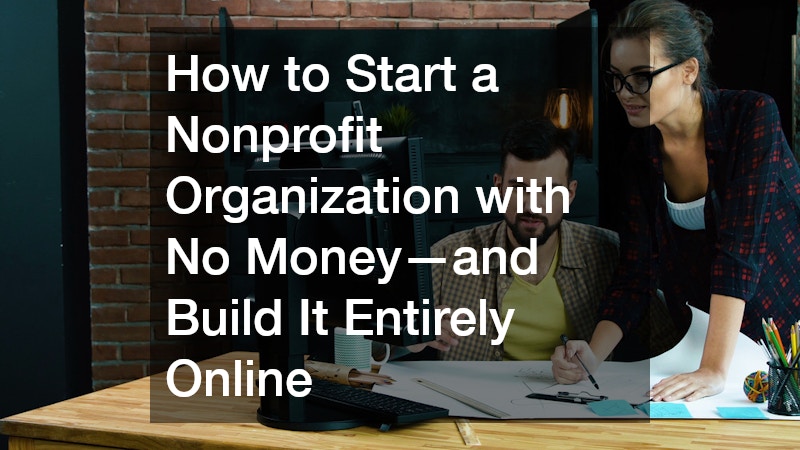Starting a nonprofit might sound like something only wealthy philanthropists or large institutions can do. But the truth is, you can start a nonprofit organization with no money—and even better, you can do it completely online.
If you have a mission, a cause you care deeply about, and the determination to take action, money doesn’t have to be your barrier. In this guide, we’ll walk you through how to get your nonprofit off the ground using free tools, volunteer help, and smart strategies that require zero up-front funding.
Why Start a Nonprofit with No Money?

Let’s be honest—many of us who feel called to help others don’t have deep pockets. Maybe you’ve seen a need in your community, experienced something firsthand, or want to fight for a cause you believe in. But what if your biggest asset is your passion, not your wallet?
Good news: You don’t need a bank loan, office space, or expensive software to launch a nonprofit. The internet has leveled the playing field. With creativity, planning, and resourcefulness, you can build a legit organization and start making a difference—without spending a dime upfront.
Step 1: Clarify Your Mission and Goals
Before you file paperwork or build a website, you need to be crystal clear about what you’re trying to achieve—and why. This is the heart of your nonprofit and will guide every action you take.
Ask Yourself:
- What specific issue or problem am I addressing? Are you tackling homelessness, mental health, animal welfare, climate change, education gaps, or something else?
- Who exactly am I helping? Narrow it down. For example: low-income single mothers in urban areas, veterans with PTSD, underserved rural students, or stray dogs in your city.
- What kind of impact do I want to make? Are you providing direct services, raising awareness, advocating for change, or connecting resources?
- How will I measure success? Think in simple, clear terms. How many people served? How much food distributed? How many lives improved?
Write a Mission Statement
Once you’ve answered these questions, condense your purpose into a 1–2 sentence mission statement. This is your nonprofit’s compass.
Example: “To provide free virtual mental health coaching to first-generation college students across the U.S., using a volunteer-based support network.”
Tip: Keep it outcome-focused. Avoid vague language like “empowering” or “supporting” unless you explain how.
Step 2: Choose a Name and Secure a Digital Presence
Your nonprofit doesn’t need a fancy building or corporate-style branding. But in the digital world, a clear identity and online visibility are essential.
Pick a Memorable Name
A good name should:
- Reflect your cause or values
- Be easy to pronounce and spell
- Sound professional enough to earn trust
- Be available across domains and social media
Avoid: Obscure acronyms, long phrases, or trendy slang.
Test It: Ask friends or strangers: “What do you think this organization does?” If they’re confused, reconsider.
Check Name Availability
Before you fall in love with a name, make sure it’s available:
- Namechk – Checks domain names and major social platforms
- Your state’s nonprofit registry – To avoid legal issues or duplication
Get a Free Website and Email
Your website is your digital headquarters. It doesn’t need to be fancy—just clean, informative, and mobile-friendly.
Free website builders:
- Wix – Easy drag-and-drop builder with nonprofit templates
- Carrd – Great for single-page nonprofits or landing pages
- Google Sites – Basic and functional
- WordPress.com – Ideal for blog-focused content
Free Email Options:
- Gmail – Use your nonprofit’s name (e.g., helpinghandsorg@gmail.com)
- Zoho Mail – Free custom domain email (e.g., info@helpinghands.org)
Tip: Avoid using personal emails like johnny@hotmail.com—it looks unprofessional to potential donors or partners.
Step 3: Build Your Founding Team (Volunteers Only!)
You don’t need to pay staff to start strong. In fact, most successful nonprofits begin with volunteers—people who believe in the cause and want to help.
Why You Need a Team
Even small nonprofits benefit from having a group of committed collaborators. A founding team helps you:
- Share the workload
- Get new ideas and perspectives
- Gain credibility
- Fulfill legal requirements (some states require a board of directors)
Key Roles to Look For:
- Admin/Operations Lead: Handles scheduling, coordination, and back-end tasks
- Marketing/Social Media Person: Creates posts, builds your brand
- Fundraising/Donor Outreach: Researches grants, sets up fundraising tools
- Legal/Compliance Advisor: Reviews documents, filings, bylaws
Where to Find Volunteers:
- LinkedIn: Post a call for co-founders or volunteers
- Facebook Groups: Look for local community or volunteer groups
- Idealist.org – Nonprofit-focused job and volunteer board
- VolunteerMatch.org – Match with aligned volunteers
- Reddit: Subreddits like r/volunteer or r/socialimpact
Pro tip: Be upfront. Let people know you’re starting something from scratch and looking for collaborators, not employees. Passion matters more than résumés at this stage.
Step 4: Make It Legal—For Free (or Close to It)
You can start by building your community and programs before registering legally. But if you plan to fundraise or apply for grants, you’ll eventually need to formalize your structure.
Do You Need to Incorporate Right Away?
Nope. You can operate informally as an unincorporated nonprofit association, especially if you’re testing ideas or running grassroots campaigns. Just be cautious: without legal structure, your personal assets could be at risk.
When You’re Ready, Here’s the Budget-Friendly Path:
1. File Articles of Incorporation
- Go to your Secretary of State’s website
- Fill out the required form for nonprofit incorporation
- Fees range from $0–$50 in many states (e.g., Kentucky, Mississippi, Colorado)
2. Get Your EIN (Employer Identification Number)
- Apply online at IRS.gov
- Completely free
- Required for opening bank accounts, hiring staff, or filing taxes
3. Apply for 501(c)(3) Tax-Exempt Status
- Use Form 1023-EZ if eligible (most nonprofits under $50K/year can)
- Filing fee: $275 (as of 2025)
- Apply online via the Pay.gov portal
Free or Low-Cost Legal Help:
- SCORE – Free nonprofit mentoring
- LawHelp.org – Find local legal aid
- Local law schools – Many offer pro bono legal clinics for nonprofits
- Nonprofit associations – Some provide low-cost setup services
Step 5: Use Free Tools to Run Everything Online
You can run 100% of your operations online without paying for software. Here’s a toolkit to get started:
Communication & Collaboration
- Slack – Organize team convos by topic
- Discord – Great for community-building and real-time chat
- Google Workspace (nonprofit) – Docs, Sheets, Gmail, Calendar, Drive
(Tip: You can apply for the full nonprofit suite once you’re registered)
Project Management
- Trello – Kanban-style boards to assign and track tasks
- Asana – Ideal for teams with multiple ongoing projects
Design & Outreach
- Canva (Free Nonprofit Plan) – Create logos, flyers, social graphics
- Mailchimp (Free Plan) – Email campaigns up to 500 contacts
- Linktree or Beacons.ai – Link hubs for your bio on Instagram/TikTok
Fundraising Platforms
- Givebutter – Donation pages, event ticketing, text-to-donate
- GoFundMe – For early-stage or project-based fundraising
- PayPal for Nonprofits – Low transaction fees + donation buttons
- Stripe for Nonprofits – Accept cards and recurring donations
Step 6: Start Building an Online Community

Your supporters won’t just be donors. They’ll also be volunteers, social media followers, cheerleaders, and allies. Building community is your most powerful long-term strategy.
Where to Show Up (Free Platforms):
- Instagram: Share behind-the-scenes, volunteer highlights, impact stories
- TikTok: Short videos that explain your mission or show progress
- Facebook Groups: Great for starting a niche community
- LinkedIn: Post updates and connect with mission-aligned professionals
- Medium/Substack: Publish blog-style updates and insights
What to Share:
- The “why” behind your cause
- Founder’s story
- Personal stories of those you help (with consent)
- Behind-the-scenes of your work
- Volunteer shout-outs and calls to action
Tip: Always include a next step (e.g., “Share this,” “Join our newsletter,” “Become a virtual volunteer”).
Step 7: Launch Small (But Loud)
You don’t need a gala or fancy press release to launch. Start with something doable, then use your online platforms to spread the word.
Easy First Projects:
- Free downloadable guide related to your cause
- Virtual Q&A or panel event
- Instagram Live or TikTok challenge
- Fundraising drive for a specific need (e.g., $275 for your 501(c)(3) fee)
- Volunteer sign-up campaign
Promotion Tips:
- Share across all your social media accounts
- Email friends, family, and supporters directly
- Ask your founding team to repost and amplify
- Join online forums related to your mission and share your launch
Don’t wait until it’s perfect. Launch it messy and promote it strategically, but with heart.
What About Funding? Can You Raise Money After Launching?
Yes—absolutely. You don’t need a budget to begin, but you’ll eventually need some funding to scale, expand programs, cover legal fees, and sustain operations. The good news is, many nonprofits start lean and use creative strategies to generate funds after they’ve already launched.
If you’ve built a strong mission, gathered early supporters, and shown even a little impact, you can raise money—even as a brand-new nonprofit.
Early Funding Options to Explore:
1. Micro-Grants for New Nonprofits
Micro-grants are small amounts of funding (typically $500–$5,000) designed specifically for startups and grassroots initiatives. Many are easy to apply for and don’t require 501(c)(3) status upfront.
Where to look:
- Local foundations or community giving programs
- National initiatives like the Pollination Project or SeedMoney
- Philanthropic funds targeting your issue area (e.g., youth, arts, health)
- Bank and credit union community reinvestment programs
Tip: Start collecting your impact data early—even if it’s just number of volunteers, social media engagement, or testimonials.
2. Online Fundraisers (Givebutter, GoFundMe, Facebook Fundraisers)
Crowdfunding platforms are a popular and fast way to generate seed money.
How to succeed:
- Create a clear, emotionally compelling campaign story
- Set a specific goal (e.g., $275 for your 501(c)(3) fee)
- Share real-life photos or videos
- Ask your founding team and early supporters to share widely
Tools to try:
- Givebutter – Donation pages, live fundraising events, text-to-give
- GoFundMe – Great for initial launches or urgent needs
- Facebook Fundraisers – Free, especially powerful if your network is active there
3. Recurring Donation Campaigns
Recurring donors—even just a few—can provide stability over time.
Why it works:
- Smaller asks (e.g., $5/month) feel manageable to supporters
- Helps you plan ahead knowing what funds are coming in
- Builds a long-term relationship with your audience
How to set it up:
- Use tools like Givebutter, Donorbox, or PayPal recurring donations
- Create a special “Founding Donors Circle” for your first 20 monthly supporters
- Offer non-monetary perks like shout-outs, early updates, or behind-the-scenes access
4. Partnerships with Local Businesses
Local business owners often want to support causes in their community—they just need to be asked.
Ways they can help:
- Sponsor an event or resource in exchange for brand recognition
- Donate a percentage of sales for a limited time
- Offer in-kind support like printing, food, space, or tech services
- Let you place a donation jar or flyer in-store
Tip: Start by building relationships. Don’t cold-pitch; instead, show them how their involvement adds value to both sides.
5. In-Kind Donations (Services, Space, Gear)
In-kind donations are just as valuable as money—sometimes more.
Common in-kind donations:
- Graphic design, web development, accounting or legal services
- Zoom Pro accounts, software licenses, email marketing tools
- Office supplies, marketing materials, printing
- Event or meeting space
- Equipment like laptops, phones, or photography gear
Where to find them:
- Ask your network for referrals
- Join local business chambers or nonprofit Facebook groups
- Use platforms like Catchafire or Taproot for skilled volunteer matches
Common Mistakes to Avoid When Starting with No Money
Starting with zero funding forces creativity—but it also comes with its own set of pitfalls. Here’s what to watch out for:
1. Waiting for “the right time”
You don’t need the perfect name, the perfect plan, or a full website to start. Waiting too long can kill your momentum before it even begins.
Do this instead: Start with what you have. Launch a simple awareness campaign, start posting online, or host a small virtual event. Action builds clarity.
2. Trying to do everything alone
Founders often burn out because they think they need to do everything themselves—especially when they can’t afford to hire.
Do this instead: Invite people in. Ask for help. Build a small, trusted team. There are passionate people who would love to contribute, even in small ways. Your vision will grow faster with shared effort.
3. Focusing only on money, not mission
Yes, you need funding—but if that becomes your only focus, you risk losing the heart of your cause. Donors and partners care about impact, not just budgets.
Do this instead: Focus on showing your work. Help one person. Solve one problem. Post one story. Passion and results build credibility, which brings in funding organically.
4. Overcomplicating the structure
Many founders get stuck on bylaws, org charts, and legal nuances before they’ve served a single person. That stuff matters—but not on Day 1.
Do this instead: Start simple. Use templates. Incorporate when you’re ready. Focus on validating your idea and building trust before creating a 20-page strategic plan.
5. Ignoring your audience
It’s easy to assume you know what your target group needs—but assumptions can lead to wasted time, energy, and resources.
Do this instead: Talk to people. Listen. Ask questions. Run surveys. Test ideas before scaling. Your programs will be more effective and easier to fund when they’re built around real needs.
In Closing
Starting a nonprofit with no money isn’t easy—but it’s absolutely possible. With today’s tools, platforms, and connected communities, you can launch entirely online, build your following, and grow your impact before spending a cent.
The key? Start small. Stay focused. Use what you have. Be resourceful.
Your cause matters—and people want to support it. You just need to show up and take the first step.
TL;DR: How to Start a Nonprofit Organization with No Money—And Build It Entirely Online
- Clarify your mission and who you serve
- Choose a name and get a free online presence
- Recruit a small volunteer team
- Legally register using low-cost or free resources
- Run operations with free digital tools
- Build your community online
- Launch a small initiative to prove your concept
- Fundraise once you’ve built trust and shown impact




